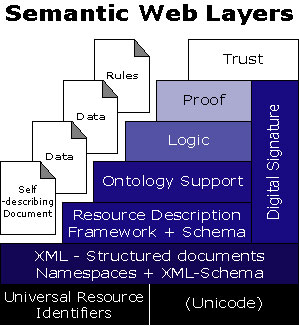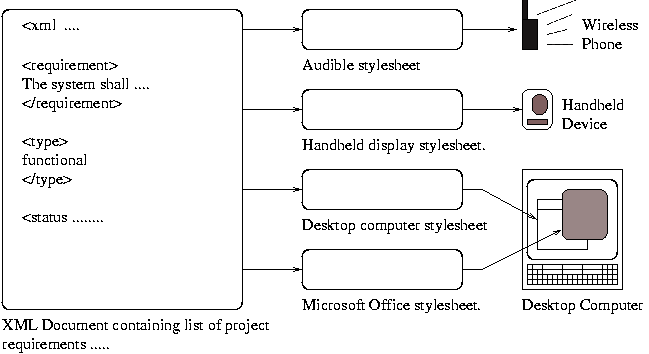![[Collaborative SoS]](sos/sos-definition.gif)
Figure 1. Cooperating transportation services for home-to-home travel
The key challenge in creating an efficient system is synchronization timetables and capacities so that passengers can transition from one mode of transportation to another.
![[Systems of systems]](sos/sos-diagram.gif)
A system of systems is a collection of independently useful/operational systems which have been glued together to achieve further emergent properties.
The primary design focus is on the interfaces, specifically the communication standards, as very little can be done to modify the monolithic systems.
Systems of systems can be classified into three types:
Coerced Systems of Systems
Example -- Windows Operating System
Example -- Smart House
Collaborative Systems of Systems
Designers must consider why these systems will choose to collaborate, and then foster those reasons in the design. A working system will depend on the interfaces between individual systems.
Example -- Transportation Services at an Airport
![[Collaborative SoS]](sos/sos-definition.gif)
Figure 1. Cooperating transportation services for home-to-home travel
The key challenge in creating an efficient system is synchronization timetables and capacities so that passengers can transition from one mode of transportation to another.
Example -- An Orchestra
Chaotic Systems of Systems
Chaotic (or virtual) systems of systems do not have a centralized management structure.
Examples -- The Internet and Open Source Software Development
![[Collaborative SoS]](sos/sos-linux-penguin.gif)
![[Collaborative SoS]](sos/sos-www.gif)
The penguin is the icon for Linux, an open source operating system.
Chaotic systems of systems work because the various systems find the interface standards to be advantageous. Companies build web pages which adhere to the HTML standard not because they have to, but because it is economically advantageous to.
Our research approach:
Our research approach is motivated in the next two sub-sections.
Requirements Management Systems are Chaotic Systems of Systems
Requirements management systems need to deal with internal and external requirements. Internal requirements are generated from within a project. The latter emanate from external sources (e.g., the EPA may mandate that a system must satisfy certain environmental regulations).
![[Systems of systems of Requirements]](sos/sos-requirements.gif)
Figure 2. Flow of requirements in team-based system development.
Points to note:
Monolithic System
A requirements management systems can be implemented as a monolithic system. But as soon as the need to leverage or reuse the requirements across projects, companies, and industries is found, a monolithic system approach is no longer viable. (i.e., it is unrealistic to expect that all companies participating in a large project will conform to a standard set of requirements management tools, or any other tool for that mattera.)
Chaotic System of Systems
The chaotic system of systems is a more appropriate model because every project, company, and "regulations authority" will operate based on personal needs and desires.
Thus, an open standard is needed which will allow the various systems to share a common data structure and build customized tools to meet the personal needs.
In his original vision for the World Wide Web, Tim Berners-Lee described two key objectives:
During the 1990-2000 time frame, the first part of this vision has come to pass.
The aims of the Semantic Web are to
Modeling
The Semantic Web Layer Cake

Figure 3. The Semantic Web Layer Cake (Berners-Lee, 2002).
The Semantic Web will be assembled from a layer cake of technologies:
XML separates structure from presentation, thereby allowing for presentation to be customized to capabilities of the end device. e.g.,

The adjacent figure shows the pathway of development and execution for an xml-based application.
![[XML DOM Tree ]](sos/xml-domtree.gif)
It is convenient to partition this pathway into two phases: (1) Definition of the XML Document, and (2) XML document processing.
Phase 1: Definition of the XML Document.
XML documents are defined in two parts: (1) a document type definition (DTD), and (2) the XML markup itself.
Most often these parts will be defined in separte files (as shown in the figure above), but it is possible to embed the DTD in the same file as the XML markup. An example of the latter is shown below.
Phase 2: Processing an XML Document Processing.
XML documents are processed by a combination of: (1) parser and (2) application programming interface (API) software.
Some pasers are able to check (or validate) that an instance of an XML document against the data type definition (DTD) that is used to describe the vocabulary, and to check whether the actual markup conforms to the rules of the markup language.
RDF separates content from structure, thereby allowing for the merging of multiple conceptual models.
Click here an example of RDF.
Note. XML technologies are an integral part of the AP233 interchange format for requirements.
Simple Example (... for how things will eventually work)
Today's search engines rely on "keywords."
![[System Rules]](sos/system-rules.gif)
Suppose that an ontology (i.e., conceptualization of a domain) of people relationships tells us:
Concept 1. If "a" is married to "b" then "a and b are friends"
Concept 2. If "a" and "b" are "best friends" then "a" then "b" are friends.
Concept 3. If "a" is a friend of "b" then "b" is a friend of "a."
And suppose that we could represent facts on the web.
Fact 1. John and Mary are married.
Fact 2. Jane's best friend is Mary.
With these concepts and facts in place, a semantic search engine should be able to accept queries of the type:
Query 1. Who are Mary's friends?
and answer with:
Answer. John and Jane.
Note. Concepts limit the "design space" by placing constraints around the set of (potentially) feasible solutions (c.f., differential equations in engineering).
We need a framework to support synthesis of system architectures enabled by product descriptions on the Web.
![[Home Theater]](sos/home-theatre.gif)
Figure 4. Simplified Architecture of a Home Theater System
Figure 4 shows elements of a top-down/breadth first development (decomposition) followed by a bottom-up implementation procedure (composition). Looking ahead, we envision database libraries of object-specification pairs from which components can be selected.
This so-called "systems integration" problem has become key and perhaps the most profitable engineering practice.
Attaching Specifications to Objects and Components
We envision the development of object-specification pairs that define a set of behaviors offered by a component/object. Object/component descriptions must be at least multi-input multi-output (MIMO), otherwise they aren't useful.
![[Elements of an Object-Specification Pair]](sos/system-reuse3.gif)
Figure 5. Elements of an Object-Specification Pair
An interface specification precisely defines what a client of that interface/component can expect in terms of:
Together the pre- and post-conditions and satisfaction of the input requirements constitute a contract.
Selection of Sensors from a Database
Suppose that it were possible to create a family of sensor-specification pairs (probably expressed in XML and RDF).
![[Object-Specification Pairs 1]](sos/sensor-database1.jpg)
Figure 6. Formulation of Sensor-Specification Pairs
Then, we could create and XML database graphical frontend for browsing the database and answering suitable queries:
![[XML database]](sos/sensor-database2.jpg)
Figure 7. Architecture of XML database and graphical frontend.
Developed in October 2006 by Mark Austin
Copyright © 2006, Mark Austin, University of Maryland.